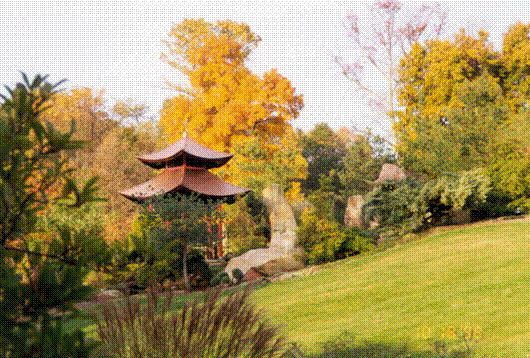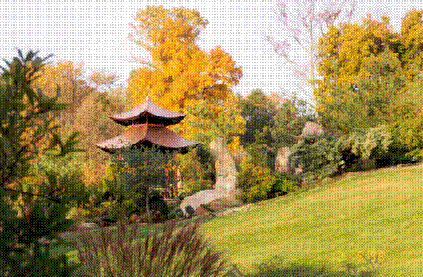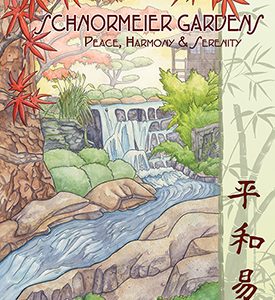
Ted, Ann, David and Kimberly Schnormeier moved to Knox County in the summer of 1966. They acquired the house and three acres at 8542 Laymon Road, directly across the road from what is to become the future Visitor Center.
Ann often remarked that she would not like to see homes built in the field to the South and East of that home but that it should remain open green space. She got her wish for Christmas 1986 when Ted surprised her with a present of that twelve-acre parcel. Shortly thereafter, the eighty-acre parcel that is now the Gardens was sold and sub-divided into 2 ½ acre lots and the first new home was erected.
It was at that time that it was decided to expand the area that we would like to preserve and remain undeveloped. By the time this process was completed in 1994 we owned a total of twelve separate parcels including six residences and 125 acres. All of this was contiguous property and was on Laymon Road bounded by Baker Road on the South and Glen Road on the North. The acquisition purpose was to clean up these properties, preserve the rural nature of the area and keep them from being developed.
By the time this process was completed in 1994 we owned a total of twelve separate parcels including six residences and 125 acres.
The clean up process started with the acquisition of the properties and was mostly completed by 1993. During this time, houses were moved, remodeled, or burned down. Fields and fence lines were cleaned up of multiflora rose, dead and fallen trees and miscellaneous collections of debris. The fields were planted into hay fields. Over a mile of horse fence was installed in 1989 and 1990. Three hundred Acer rubrum ‘October Glory’ maple trees were planted over three successive springs starting in 1989. Also, in 1989 the five-acre lake was built and stocked and the dock house and red Chinese Bridge were built.
The property was now starting to look like something and we felt it needed to be named. We named it San-Jule Abrabian Farms. This was really a family joke, as we owned one Arabian mare and multiple farms!
The appearance of the properties continued to improve with the fence, trees, lake, and structures all ‘settling in’ and looking like they belonged. Ann started suggesting that a perfect site for a new home had been created – although that had never been the intention – Ted pretended to never hear the suggestion.
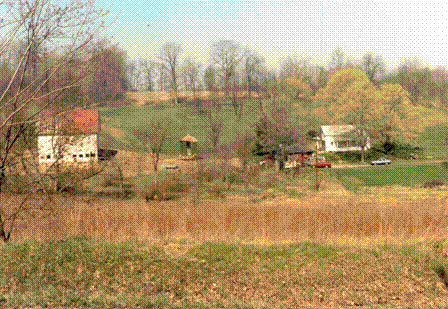

Photograph of home site at acquisition
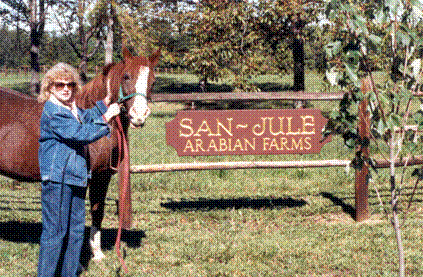

Ann and San-Jule – aka Julie
In 1992 Ted finally relented and asked Ann to suggest the specific site and draw a floor plan of what she had in mind. It was at this time that Ted’s enthusiasm for the project grew and he drew all of the plans over several weekends of that year. The determination was made to proceed and construction commenced in April of 1993.
The site itself suggested a long and low house that would be nestled into the hillside on the West side of the lake. Both Ted and Ann, being Frank Lloyd Wright enthusiasts as well as ‘Fallingwater’ fans, decided to use that as their inspiration for the actual siting, exterior appearance and interior philosophies. The result is an exterior appearance of Fallingwater ‘stretched out’ as opposed to being ‘stacked up.’ The dominating copper roof structure is meant to resemble a Japanese village. FLW exterior styling clues are the roof with its large overhangs, massive amounts of glass (Ted was in the window business after all), cantilevered decks, the shape and color of the deck railings and the Wisconsin limestone and stucco exterior finish. The rear of the house continues this influence with the intimate Japanese Garden and the ‘rain chains’ used in lieu of downspouts. The house is 156 feet long and comprises 4600 square feet.
From the moment one approaches the cast bronze front doors and enters the foyer, the FLW influence continues. The use of excellent design and high quality construction materials and décor combine to create a structure that functions both as a dwelling and as a work of art. The house was completed in April 1994 and Ted and Ann moved in on the May Day weekend.
The only landscaping intended to be part of the house project was the Japanese Garden and the area immediately South of the house to the stream. Inspired by a trip to China in 1995, ideas for an expanded garden project began to grow. That then was the beginning of ‘The Gardens’ themselves – not as a grand plan, but as an evolutionary process. That begins another story – ‘The History of the Gardens’.
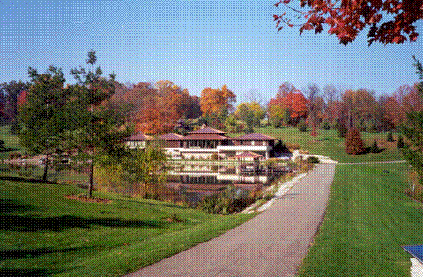

1994 and house is complete
After recovering from building our new home and living in it for over a year, it became evident that something was going to have to be done to the fifty surrounding bare and treeless acres. But what? How? Who? We possessed no previous knowledge or experience in landscaping and had next to no knowledge of plants.
After some inquiries, Van Wade of Wade and Gatton Nurseries in Bellville, Ohio suggested R. J. Stovicek & Associates of Lorain, Ohio. Bob Stovicek is an OSU landscape architect and horticulture graduate as well as being a sculptor, waterfall builder and general contractor with a lifetime of experience on large projects all over the country. His delightful wife Jeannie and other members of their firm ably assist him.
In 1996 our first meeting was held in the late spring and we discussed a number of possibilities for the property. Soon after, we reviewed scale models and proposals for the Meadow Garden, the Waterfalls Garden and the Chinese Cup Garden & Pavilion. We were all enthusiastic about the proposal and determined to proceed promptly as it was the ideal time of year; it fit their schedule and our desires. The proposal included design of the three areas, selection and placement of the plantings (exclusive of all materials) for $12,000. Little did we know at the time that before the project was complete we would exceed that amount many times over.
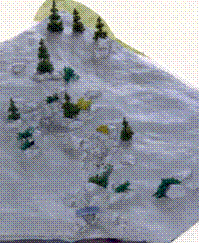

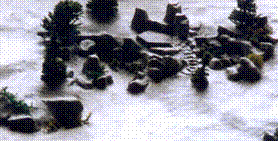

Models of large waterfalls and Chinese Cup Gardens
The next step was selecting the large rocks that would be needed to make the project a reality. To that end, we spent a day with Jerry Parsons of the Briar Hill Stone Company of Glenmont, Ohio. When we told him what we were looking for we think he believed we were certifiably crazy! (We probably were!) But, after patiently showing us several possibilities we were eventually able to reach a meeting of the minds. It was a eureka moment when he said “I know just what you want, follow me!” We did, tearing through the countryside towards their sandstone quarry number 26 in Stillwell, Ohio. He had indeed understood what we were looking for and we now stood gazing at the most enormous mountains of large to very large blocks of sandstone of every color size and shape imaginable! The photograph shown below will provide a hint of the difficult choices that had to be made. Bob Stovicek is marking one of which he was particularly fond. The next day we were like children in a candy store with no spending limit, selecting and marking the rocks we wanted. Each piece was like an individual piece of sculpture and we knew each one would tell us exactly where and how it should be placed.
The delivery process of 814 tons of rocks weighing between ten and thirty tons each, started on July 6, l996. We would eventually end up with more than twice this amount. The delivery, involving unloading and transporting the rocks to designated areas, was more stressful than can be communicated in writing. Between broken chains, cables and equipment, to unload and move many massive rocks, we were almost defeated. We employed the largest excavator we could find in the state for more than a month as well as three different cranes, bulldozers, backhoes, other excavators, tractor-trailers and trucks but finally succeeded in locating them where they belonged. Then, the necessary excavation and actual rock placement got underway and the individual projects started to look like the vision in our heads.
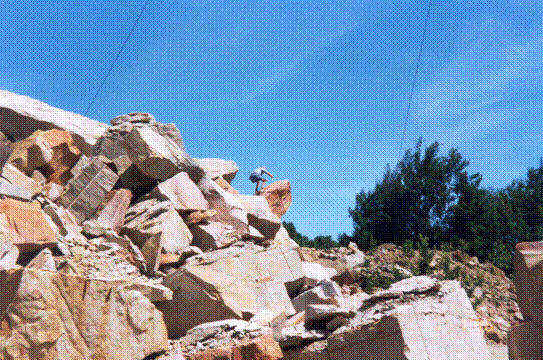

Sandstone Quarry Number 26 in Stillwell, Ohio
Now was the time to start thinking and learning about plants. To give the project the immediate appearance of pseudo maturity we placed one hundred thirty-foot White and Scots Pine trees in the general area surrounding the large lake. Many trailer loads of trees, shrubs, perennials and ground covers were placed and the repair and seeding of the lawns was completed. It was now mid-November and we concluded our activity for the year. The total amount accomplished in a relatively short period of time was utterly astounding! In just five months time the Waterfalls Garden, Chinese Cup Gardens and the Meadow Gardens were basically complete – with water roaring over the waterfalls and just waiting for Mother Nature to make her contribution. The property was starting to be transformed and we wearily headed south to our home on Sanibel Island, Florida for the winter to restore our bodies as well as our souls!
1996 was the first year we had any additional help on the property and that was in the person of Dirk Parker. Dirk served principally as groundskeeper and gardener as Ted spent nearly all of his time on the construction projects. From then on, through 2002 all of the grounds keeping duties as well as additional construction were pretty much handled by Dirk and Ted. He is a most delightful and diligent worker and friend, who has since moved on to make more appropriate use of his degree in sociology.
Further evolution continued with more plantings and refinement in 1997. The following year we constructed the Chinese Pavilion. The year 2000 saw the construction of the Japanese Teahouse – but not without incident. On the day we completed installing the twelve doors we were struck with a mini-tornado at ten PM. More than a dozen large, one hundred year old trees were destroyed. Some were on the roof of the teahouse and through the doors. It took a crew of five more than a month to clean up the mess and repair the damage.
Also in 2000, the lakes, streams and waterfalls for the Serenity Garden were constructed and the Conifer Forest was planted. At this point, (even though it might not sound like it) the construction and development process was beginning to wind down and we were looking for other enhancements we might include. We determined that the addition of sculpture would be an asset for our enjoyment as well as that of others. We started with several pieces and anticipated opportunities for more – but that is another story – Art in the Gardens.
2001 saw the construction of the Japanese Garden House and the placement of the rocks for the Stream forming the backbone for The Stream Garden. Also, in November of this year the initial planting of rare conifers commenced in the Serenity Garden – finally completing the vision for this area. Kary and Gary Gee of Gee Nurseries of Stockbridge, Michigan most ably assisted us in our selection of this stock. The Winter of 2002 saw the start of The Woodland Garden with the initial clearing of the one-half mile long walking trail.
The spring of 2003 brought the planting of many trailer loads of plant specimens in the Stream Garden completing that area. Also, two pieces of sculpture were placed in 2003 – two others from the same series having been placed in 2002.
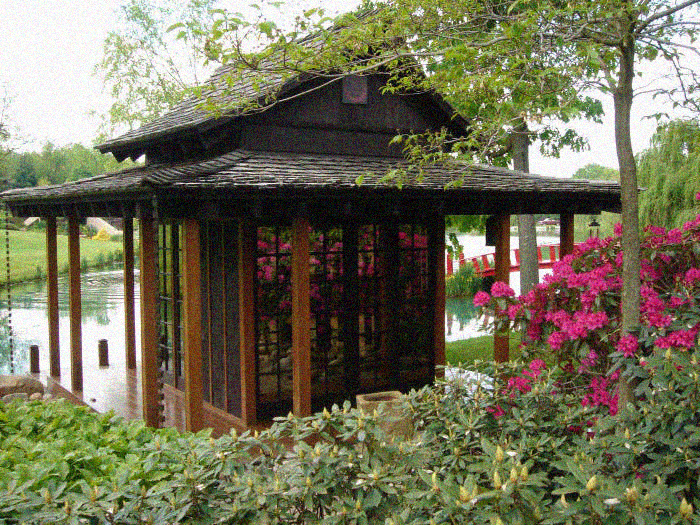

Japanese Teahouse
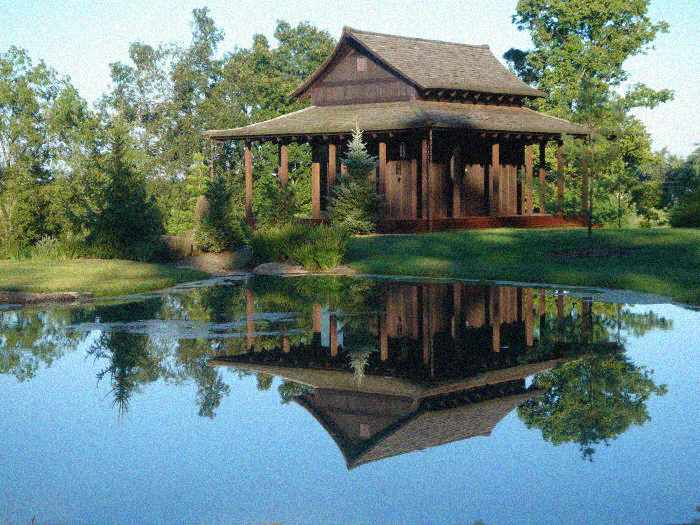

Japanese Garden House
It is now in the winter of 2004 and much effort is going into cleaning up the woods around the new walking trail in the Woodland Garden. Throughout the development of The Gardens, there was much effort expended on maintaining the property, as well as considerable numbers of additional plantings all over the area. This is expected to continue as the story of this garden as with any garden never has an end. . . just another new beginning.
The history of the development of The Gardens would be incomplete without a description of a few sticky situations that we got ourselves into. They are as much for your amusement as enlightenment – though as we were dealing with them they were very serious and had potentially serious consequences. The incidents /stories are only a very few of which might be told.
Further evolution continued with more plantings and refinement in 1997. The following year we constructed the Chinese Pavilion. The year 2000 saw the construction of the Japanese Teahouse – but not without incident. On the day we completed installing the twelve doors we were struck with a mini-tornado at ten PM. More than a dozen large, one hundred year old trees were destroyed. Some were on the roof of the teahouse and through the doors. It took a crew of five more than a month to clean up the mess and repair the damage.
The opportunity exists to weave three miserable situations into one story – so here goes! A large well was drilled in the Serenity Garden as the water source for the ponds, streams and waterfalls located there. We told the well driller we needed a minimum of 500 gallons per minute. With the 8” well down to four hundred feet he stated that it would produce between 4-500 gallons per minute as required. To go any deeper would risk hitting salt water, natural gas or oil. We stopped there, as water was what we needed. To get this many gallons to the head of the well required a 50 horsepower submersible pump – larger than any the pump manufacturer had ever produced. To run this pump, massive amounts of power was brought from across the road, under the road and driveways and around ponds. This was an extremely costly process and required a substation large enough to run a factory.
The lakes were excavated and the pump was turned on. It produced a vast amount of water for a few seconds, until it had pumped the well empty, and then only a trickle! It was determined that the well actually produced less than 100 gallons per minute and required replacement of the 50 hp pump with a 10 hp pump. In the process of changing the pump, the pump man needed some additional tools, which he called his father to bring out. Unfortunately, he neglected to watch where he was going, drove directly into one of the lakes, and almost completely submerged his car. He managed to safely escape with the able and courageous help of Dirk. The evenings’ excitement left us all drained.
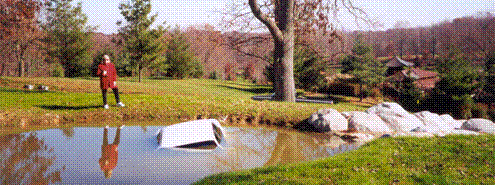

Submerged Car
The pump was replaced and was now working as expected. However, the eighty gallons per minute over the waterfalls and down the stream was most disappointing. To correct this situation an electric line was run from the panel up in the Serenity Garden, down to the large lake, a well pit and pump was installed and a 6” water line was run from the large lake to pond number four to provide the necessary volume over the waterfalls to provide a satisfying effect.
When the Conifer Forest was planted we also placed some trees in the Stream Garden. Unfortunately, we lost track of the location of the 480v electric line and water line and much to our shock, the 3’ auger went right through them – fortunately without killing anyone! It was now just prior to Thanksgiving and I declared that we were done for the year – as we had already done enough damage for one year! We escaped to Florida.
Upon returning in the spring we found all five of the lakes nearly empty. This confirmed our suspicion that they all leaked despite excellent clay soil conditions. It was now readily apparent that the excavation contractor had done an inadequate job of compacting the soil. Now what? We contacted a ‘pond sealing’ company that sprays a solution of Bentonite and polymers onto the lake surface. It then settles and seals the lakes. It did nothing, except to drain our wallet.
Uncertain about how to proceed, we did nothing the next year. By running the pump in the well continuously we kept the water pristine and clear enabling us to see a small frog sitting on the bottom of an 8’ deep pond. The disadvantage was the expense of running the pump twenty-four hours a day.
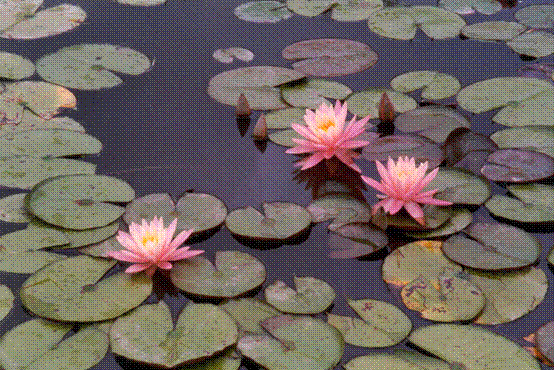

In August of 2002 we decided to bite the bullet and drained the five ponds and hauled away about 50 dump truck loads of muck. We then imported 38 trailer loads of a sealing clay called Tionesta from southern Ohio and placed an 8” layer in all of the ponds. We started to again fill the ponds producing what was cloudy, gray colored and disappointing water quality. There was no clarity for even 1”! Plus, after a very short time it also became apparent that the lakes were still leaking, maybe at an even greater rate than before. This was not a good situation!
Because we didn’t know what to do, we just ignored it. However, by mid-summer it made itself known to us by leaking this very cloudy water into the aquifer and coming out of the faucets in our house. It ruined our well, pump, and many of the faucets. We put in a new pump and the most extreme filtration system available. It did nothing. The problem remains ongoing – sometimes the water is clear and sometimes cloudy and the ponds still continue to leak!
We are currently funding a study at the Geology Department at the University of Cincinnati and working with a hydrological firm searching for a solution. What does all of this cost and what was the cost to date for this situation? You don’t want to know and neither do we!
And herein lies the joy of gardening – many triumphs, many failures. But, it is a creative, challenging and completely engaging process. We find the result pleases the eye, feeds the soul and brings joy in the sharing.
